sensor TOYOTA 86 2022 Owners Manual
[x] Cancel search | Manufacturer: TOYOTA, Model Year: 2022, Model line: 86, Model: TOYOTA 86 2022Pages: 449, PDF Size: 8.5 MB
Page 29 of 449
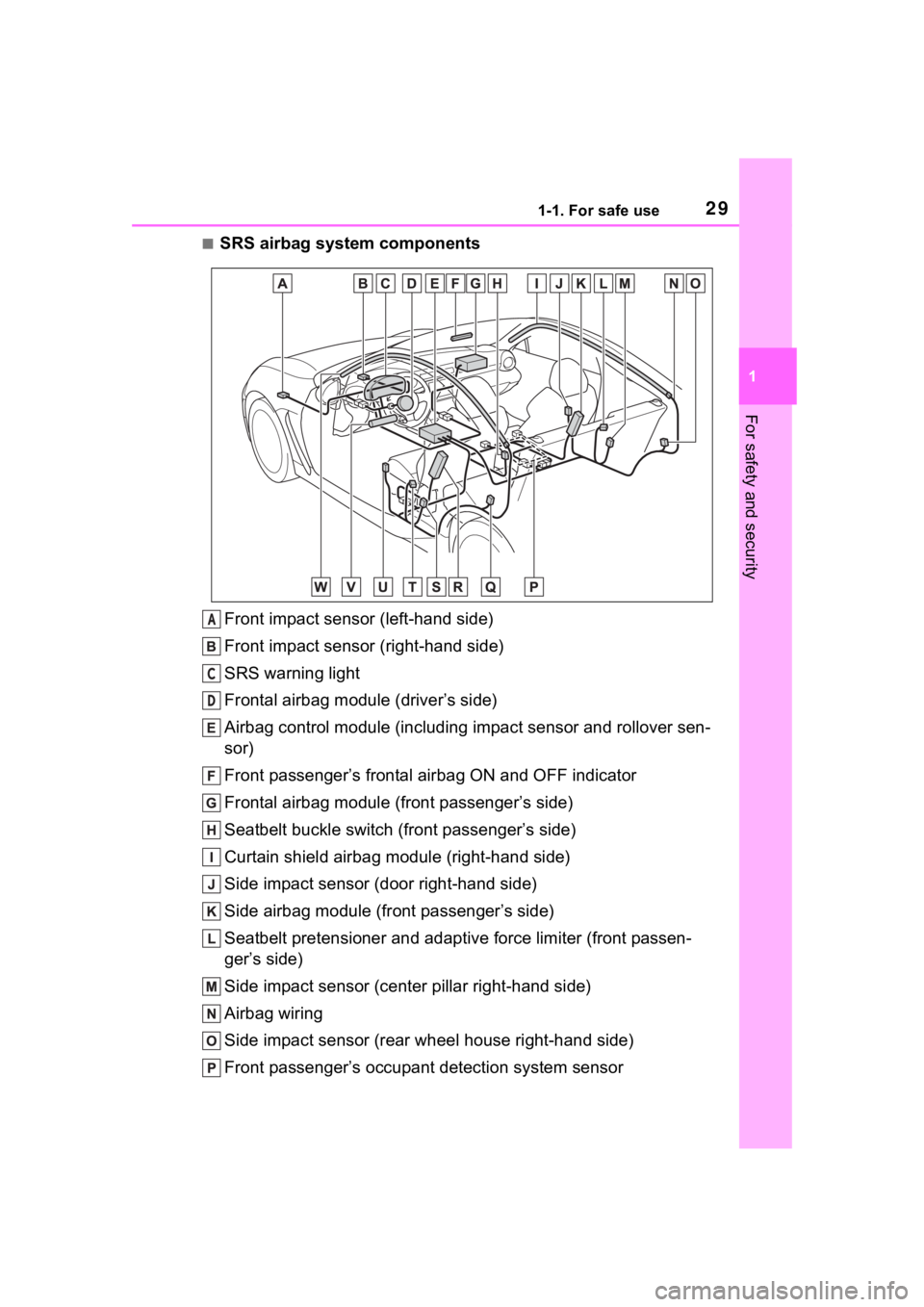
291-1. For safe use
1
For safety and security
■SRS airbag system componentsFront impact sensor (left-hand side)
Front impact sensor (right-hand side)
SRS warning light
Frontal airbag module (driver’s side)
Airbag control module (including impact sensor and rollover sen-
sor)
Front passenger’s frontal airbag ON and OFF indicator
Frontal airbag module (front passenger’s side)
Seatbelt buckle switch (front passenger’s side)
Curtain shield airbag module (right-hand side)
Side impact sensor (door right-hand side)
Side airbag module (fr ont passenger’s side)
Seatbelt pretensioner and adaptive force limiter (front passen-
ger’s side)
Side impact sensor (center pillar right-hand side)
Airbag wiring
Side impact sensor (rear wheel house right-hand side)
Front passenger’s occupant detection system sensor
A
C
D
Page 30 of 449
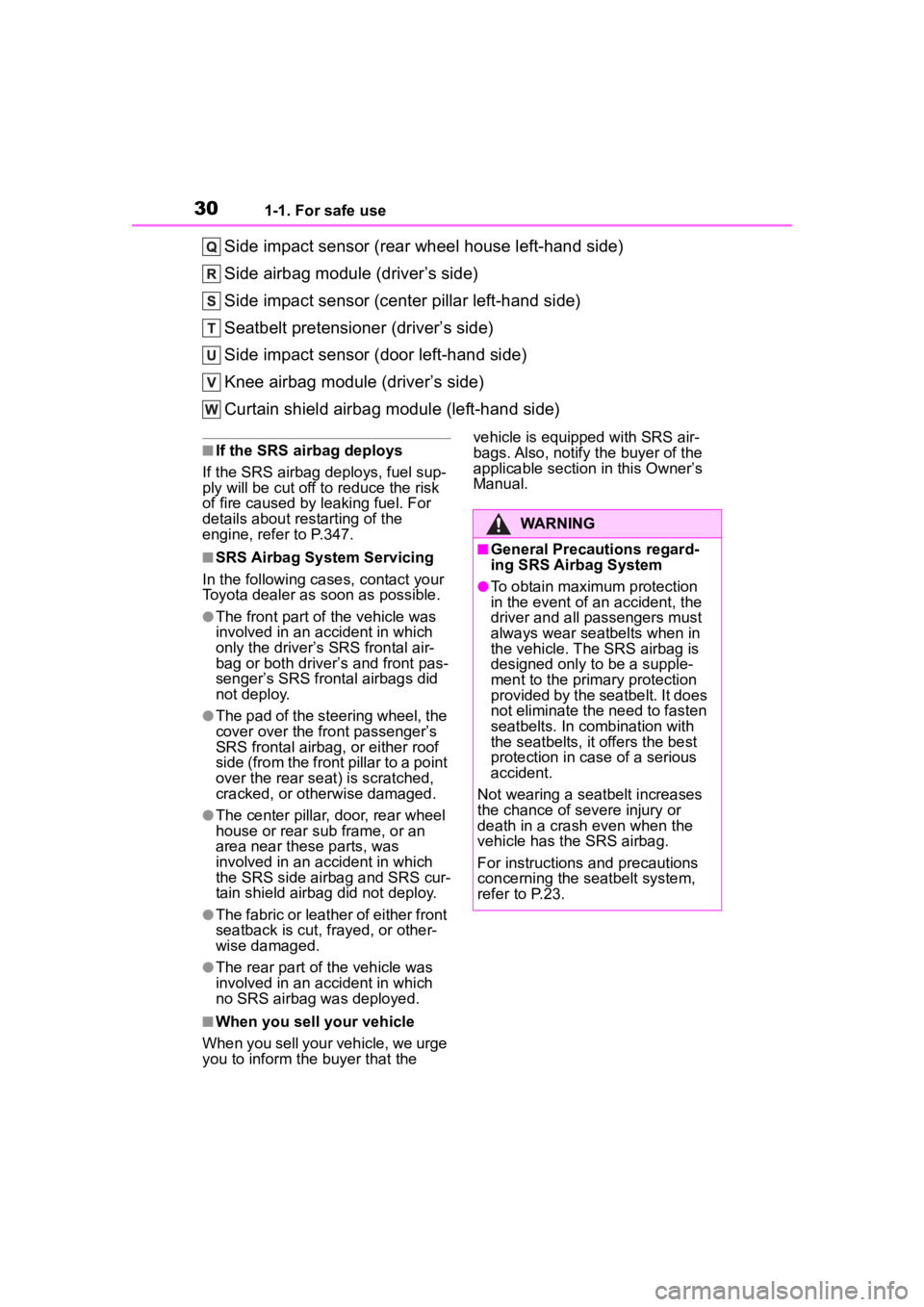
301-1. For safe use
Side impact sensor (rear wheel house left-hand side)
Side airbag module (driver’s side)
Side impact sensor (center pillar left-hand side)
Seatbelt pretensioner (driver’s side)
Side impact sensor (door left-hand side)
Knee airbag module (driver’s side)
Curtain shield airbag module (left-hand side)
■If the SRS airbag deploys
If the SRS airbag deploys, fuel sup-
ply will be cut off to reduce the risk
of fire caused by leaking fuel. For
details about restarting of the
engine, refer to P.347.
■SRS Airbag System Servicing
In the following cases, contact your
Toyota dealer as soon as possible.
●The front part of the vehicle was
involved in an accident in which
only the driver’s SRS frontal air-
bag or both driver’s and front pas-
senger’s SRS frontal airbags did
not deploy.
●The pad of the steering wheel, the
cover over the front passenger’s
SRS frontal airbag, or either roof
side (from the front pillar to a point
over the rear seat) is scratched,
cracked, or otherwise damaged.
●The center pillar, door, rear wheel
house or rear sub frame, or an
area near these parts, was
involved in an accident in which
the SRS side air bag and SRS cur-
tain shield airbag did not deploy.
●The fabric or leather of either front
seatback is cut, frayed, or other-
wise damaged.
●The rear part of the vehicle was
involved in an accident in which
no SRS airbag was deployed.
■When you sell your vehicle
When you sell your vehicle, we urge
you to inform the buyer that the vehicle is equipped with SRS air-
bags. Also, notify the buyer of the
applicable section in this Owner’s
Manual.
WARNING
■General Precautions regard-
ing SRS Airbag System
●To obtain maximum protection
in the event of an accident, the
driver and all passengers must
always wear seatbelts when in
the vehicle. The SRS airbag is
designed only to be a supple-
ment to the primary protection
provided by the seatbelt. It does
not eliminate the need to fasten
seatbelts. In combination with
the seatbelts, it offers the best
protection in case of a serious
accident.
Not wearing a seat belt increases
the chance of severe injury or
death in a crash even when the
vehicle has the SRS airbag.
For instructions and precautions
concerning the seatbelt system,
refer to P.23.
Page 36 of 449
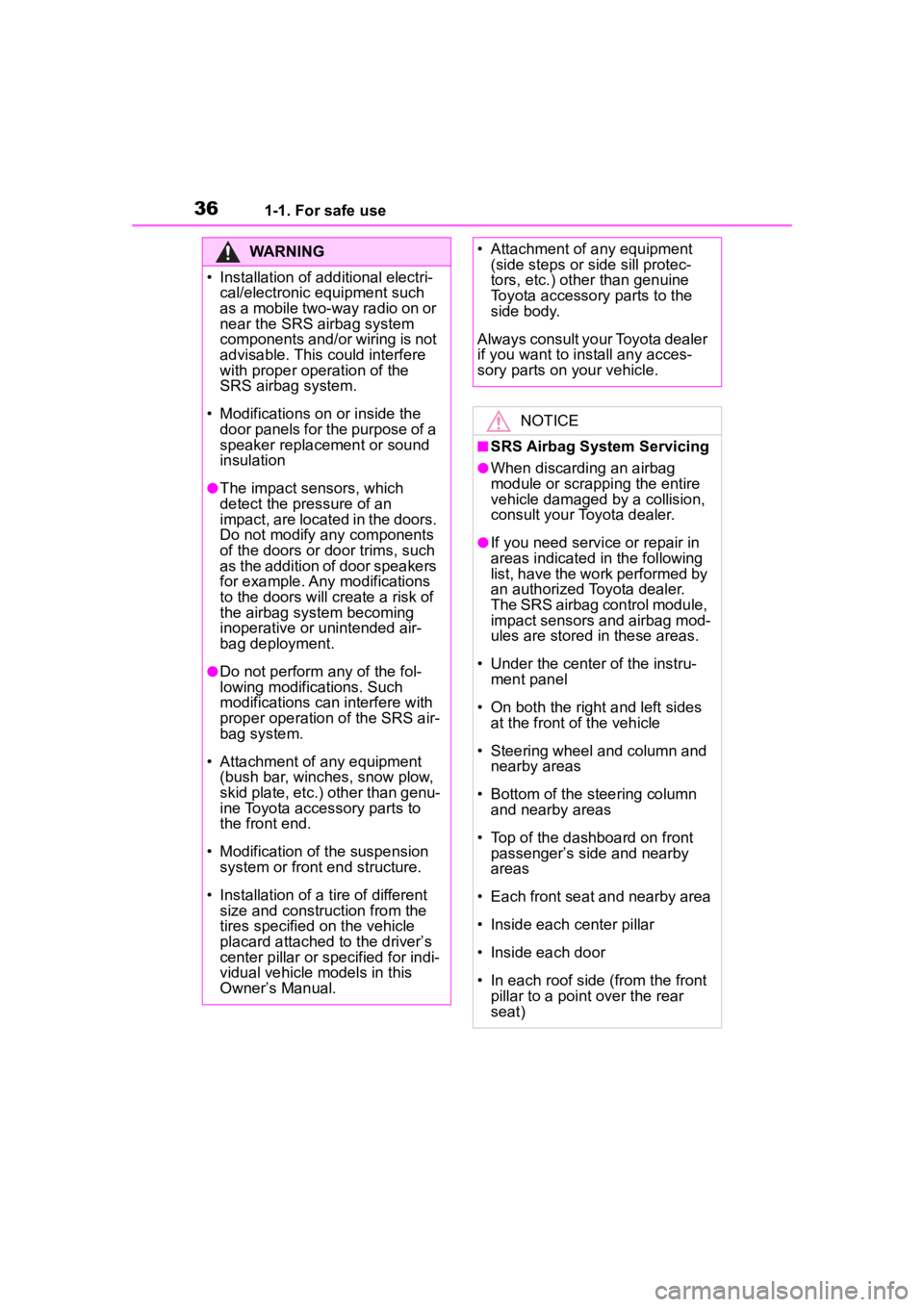
361-1. For safe use
WARNING
• Installation of additional electri-cal/electronic equipment such
as a mobile two-way radio on or
near the SRS airbag system
components and/or wiring is not
advisable. This could interfere
with proper operation of the
SRS airbag system.
• Modifications on or inside the door panels for the purpose of a
speaker replacement or sound
insulation
●The impact sensors, which
detect the pressure of an
impact, are located in the doors.
Do not modify any components
of the doors or d oor trims, such
as the addition of door speakers
for example. Any modifications
to the doors will create a risk of
the airbag system becoming
inoperative or unintended air-
bag deployment.
●Do not perform any of the fol-
lowing modifications. Such
modifications can interfere with
proper operation of the SRS air-
bag system.
• Attachment of any equipment (bush bar, winches, snow plow,
skid plate, etc.) other than genu-
ine Toyota accessory parts to
the front end.
• Modification of the suspension system or front end structure.
• Installation of a tire of different size and construc tion from the
tires specified on the vehicle
placard attached to the driver’s
center pillar or specified for indi-
vidual vehicle models in this
Owner’s Manual.
• Attachment of any equipment (side steps or side sill protec-
tors, etc.) other than genuine
Toyota accessory parts to the
side body.
Always consult your Toyota dealer
if you want to install any acces-
sory parts on your vehicle.
NOTICE
■SRS Airbag System Servicing
●When discarding an airbag
module or scrapping the entire
vehicle damaged by a collision,
consult your Toyota dealer.
●If you need service or repair in
areas indicated in the following
list, have the work performed by
an authorized Toyota dealer.
The SRS airbag control module,
impact sensors and airbag mod-
ules are stored in these areas.
• Under the center of the instru- ment panel
• On both the right and left sides at the front of the vehicle
• Steering wheel and column and nearby areas
• Bottom of the s teering column
and nearby areas
• Top of the dashboard on front passenger’s side and nearby
areas
• Each front seat and nearby area
• Inside each center pillar
• Inside each door
• In each roof side (from the front
pillar to a point over the rear
seat)
Page 37 of 449
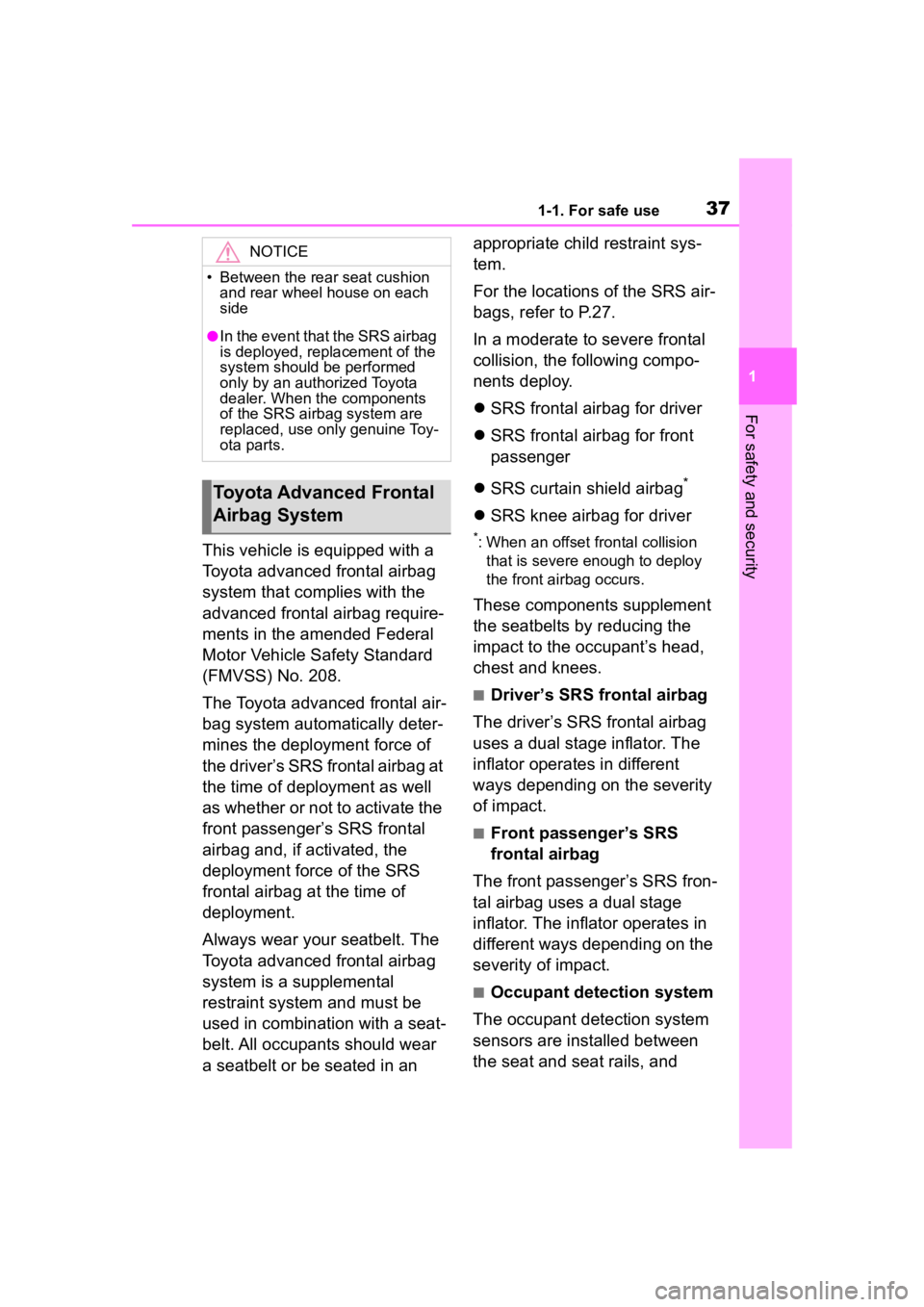
371-1. For safe use
1
For safety and security
This vehicle is equipped with a
Toyota advanced frontal airbag
system that complies with the
advanced frontal airbag require-
ments in the amended Federal
Motor Vehicle Safety Standard
(FMVSS) No. 208.
The Toyota advanced frontal air-
bag system automatically deter-
mines the deployment force of
the driver’s SRS frontal airbag at
the time of deployment as well
as whether or not to activate the
front passenger’s SRS frontal
airbag and, if activated, the
deployment force of the SRS
frontal airbag at the time of
deployment.
Always wear your seatbelt. The
Toyota advanced frontal airbag
system is a supplemental
restraint system and must be
used in combination with a seat-
belt. All occupants should wear
a seatbelt or be seated in an appropriate child restraint sys-
tem.
For the locations of the SRS air-
bags, refer to P.27.
In a moderate to severe frontal
collision, the following compo-
nents deploy.
SRS frontal airbag for driver
SRS frontal airbag for front
passenger
SRS curtain shield airbag
*
SRS knee airbag for driver
*: When an offset frontal collision
that is severe enough to deploy
the front airbag occurs.
These components supplement
the seatbelts by reducing the
impact to the occupant’s head,
chest and knees.
■Driver’s SRS frontal airbag
The driver’s SRS frontal airbag
uses a dual stage inflator. The
inflator operates in different
ways depending on the severity
of impact.
■Front passenger’s SRS
frontal airbag
The front passenger’s SRS fron-
tal airbag uses a dual stage
inflator. The inflator operates in
different ways depending on the
severity of impact.
■Occupant detection system
The occupant detection system
sensors are installed between
the seat and seat rails, and
NOTICE
• Between the rear seat cushion and rear wheel house on each
side
●In the event that the SRS airbag
is deployed, replacement of the
system should be performed
only by an auth orized Toyota
dealer. When the components
of the SRS airbag system are
replaced, use only genuine Toy-
ota parts.
Toyota Advanced Frontal
Airbag System
Page 38 of 449
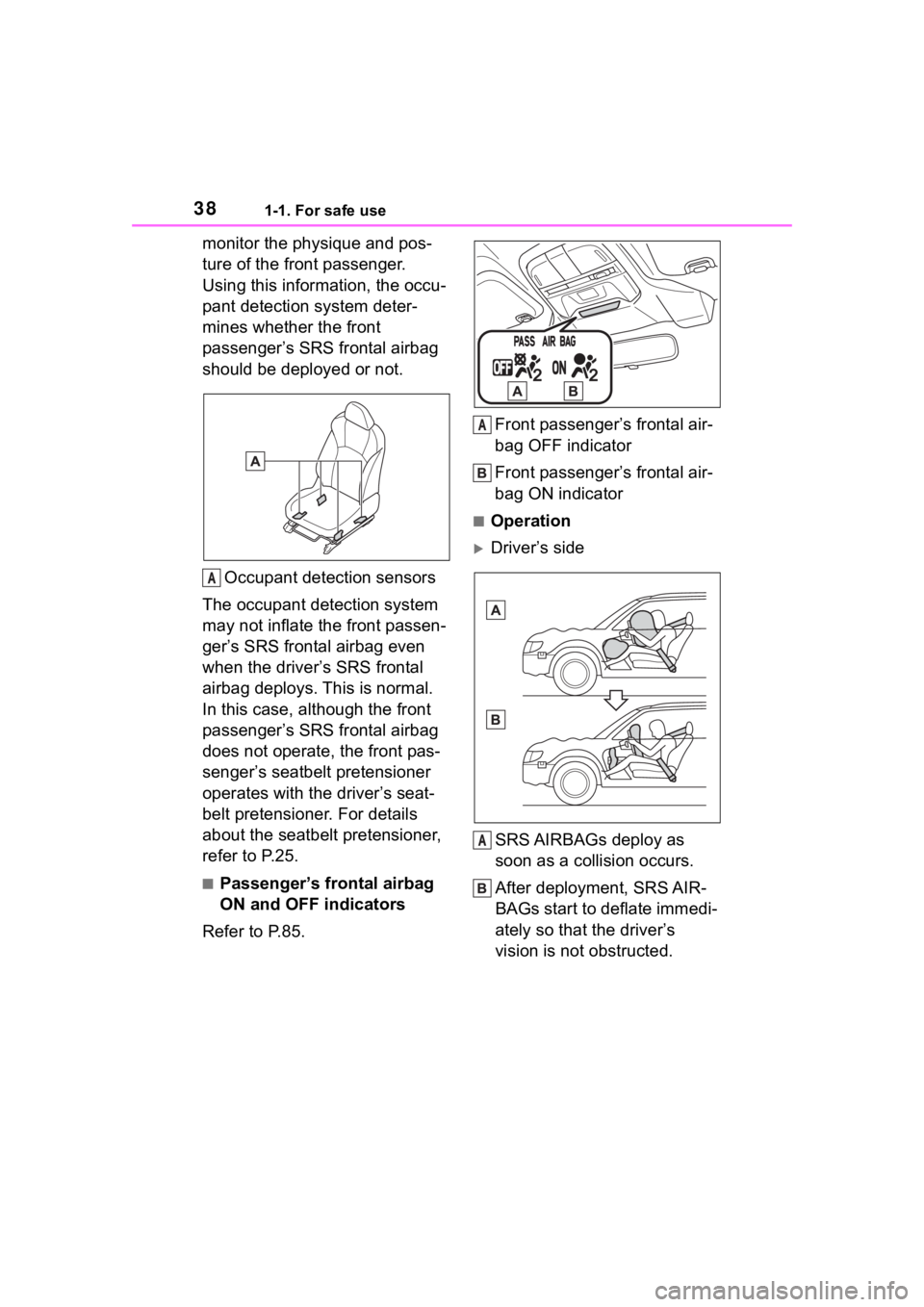
381-1. For safe use
monitor the physique and pos-
ture of the front passenger.
Using this information, the occu-
pant detection system deter-
mines whether the front
passenger’s SRS frontal airbag
should be deployed or not.Occupant detection sensors
The occupant detection system
may not inflate the front passen-
ger’s SRS frontal airbag even
when the driver’s SRS frontal
airbag deploys. This is normal.
In this case, although the front
passenger’s SRS frontal airbag
does not operate, the front pas-
senger’s seatbelt pretensioner
operates with the driver’s seat-
belt pretensioner. For details
about the seatbelt pretensioner,
refer to P.25.
■Passenger’s frontal airbag
ON and OFF indicators
Refer to P.85. Front passenger’s frontal air-
bag OFF indicator
Front passenger’s frontal air-
bag ON indicator
■Operation
Driver’s side
SRS AIRBAGs deploy as
soon as a collision occurs.
After deployment, SRS AIR-
BAGs start to deflate immedi-
ately so that the driver’s
vision is not obstructed.
A
A
A
Page 39 of 449
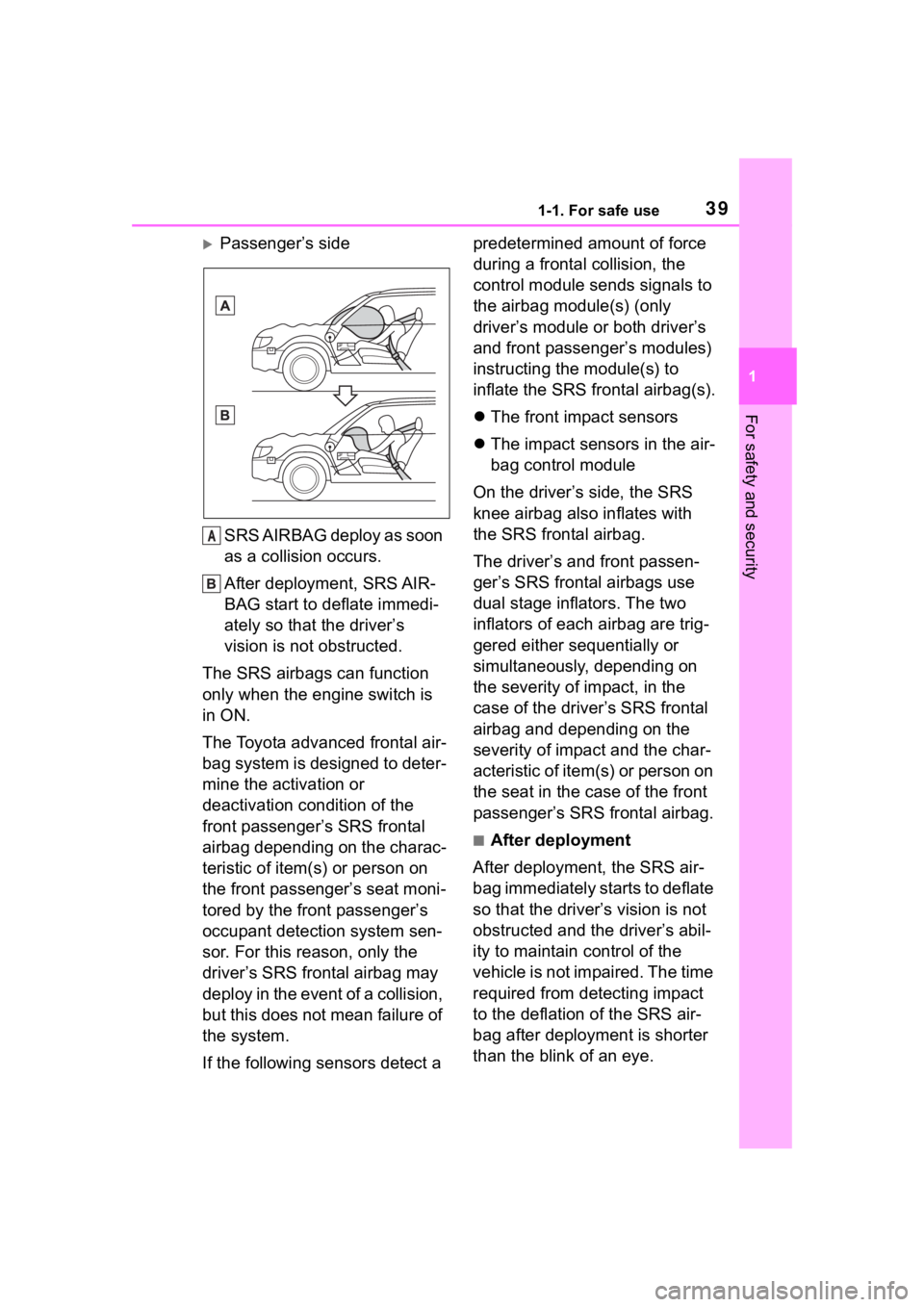
391-1. For safe use
1
For safety and security
Passenger’s sideSRS AIRBAG deploy as soon
as a collision occurs.
After deployment, SRS AIR-
BAG start to deflate immedi-
ately so that the driver’s
vision is not obstructed.
The SRS airbags can function
only when the engine switch is
in ON.
The Toyota advanced frontal air-
bag system is designed to deter-
mine the activation or
deactivation condition of the
front passenger’s SRS frontal
airbag depending on the charac-
teristic of item(s) or person on
the front passenger’s seat moni-
tored by the front passenger’s
occupant detection system sen-
sor. For this reason, only the
driver’s SRS frontal airbag may
deploy in the event of a collision,
but this does not mean failure of
the system.
If the following sensors detect a predetermined amount of force
during a frontal collision, the
control module sends signals to
the airbag module(s) (only
driver’s module or both driver’s
and front passenger’s modules)
instructing the module(s) to
inflate the SRS frontal airbag(s).
The front impact sensors
The impact sensors in the air-
bag control module
On the driver’s side, the SRS
knee airbag also inflates with
the SRS frontal airbag.
The driver’s and front passen-
ger’s SRS frontal airbags use
dual stage inflators. The two
inflators of each airbag are trig-
gered either sequentially or
simultaneously, depending on
the severity of impact, in the
case of the driver’s SRS frontal
airbag and depending on the
severity of impact and the char-
acteristic of item(s) or person on
the seat in the case of the front
passenger’s SRS frontal airbag.
■After deployment
After deployment, the SRS air-
bag immediately starts to deflate
so that the driver’s vision is not
obstructed and the driver’s abil-
ity to maintain control of the
vehicle is not impaired. The time
required from detecting impact
to the deflation of the SRS air-
bag after deployment is shorter
than the blink of an eye.
A
Page 48 of 449

481-1. For safe use
sensor.
Driver’s SRS side airbag
Front passenger’s SRS side
airbag
SRS curtain shield airbag
(right-hand side)
SRS curtain shield airbag
(left-hand side)
Therefore, they may not both
deploy in the same accident.
Also, the SRS side airbag and
SRS curtain shield airbag
deploys independently of the
driver’s and front passenger’s
SRS frontal airbags in the steer-
ing wheel and instrument panel.
For the locations of the sensors
and control modules, refer to
P.27.
■After deployment
After the deployment, the SRS
side airbag immediately starts to
deflate. The time required from
detection of an impact to defla-
tion of an SRS side airbag after
deployment is shorter than the
blink of an eye.
The SRS curtain shield airbag
remains inflated for a while fol-
lowing deployment then slowly
deflates.
The SRS side airbag and SRS
curtain shield airbag deploy
even when no one occupies the
seat on the side on which an
impact is applied.
When the SRS side airbag and SRS curtain shield airbag
deploy, a sudden, fairly loud
inflation noise will be heard and
some smoke will be released.
These occurrences are a normal
result of the deployment. This
smoke does not indicate a fire in
the vehicle.
■Example of the type of acci-
dent
The SRS side airbag and SRS
curtain shield airbag are
designed as follows:
To deploy in the event of an
accident involving a moderate
to severe side impact collision
To function on a one-time-only
basis.
The SRS side airbag and SRS
curtain shield airbag are not
designed to deploy in the follow-
ing cases:
In most lesser side impact
In most frontal or most rear
impacts (because the SRS
side airbag and SRS curtain
shield airbag deployment
would not protect the occu-
pant in those situations)
The SRS curtain shield airbags
are also designed to deploy
when the vehicle is in an
extremely inclined state such as
during a rollover. They are not
designed to deploy in most
lesser inclined states.
SRS side airbag and SRS cur-
Page 53 of 449

531-1. For safe use
1
For safety and security
A diagnostic system continually
monitors the readiness of the
SRS airbag system (including
seatbelt pretensioners) with the
engine switch is in ON. The
SRS warning light will show nor-
mal system operation by illumi-
nating for approximately 6
seconds when the engine switch
is turned to ON.
The following components are
monitored by the indicator:
Front impact sensor
• Right-hand side
• Left-hand side
Airbag control module (includ-
ing impact sensor and rollover
sensor)
Frontal airbag module
• Driver’s side
• Front passenger’s side
Knee airbag module
• Driver’s side
Side impact sensor
• Center pillar left-hand side
• Center pillar right-hand side
• Forward of rear wheel house left-hand side
• Forward of rear wheel house right-hand side
• Door left-hand side
• Door right-hand side
Side airbag module
• Driver’s side
• Front passenger’s side
Curtain shield airbag module
• Right-hand side
• Left-hand side
Seatbelt pretensioner
• Driver’s side
Seatbelt pretensioner and
adaptive force limiter
• Front passenger’s side
Seatbelt buckle switch
• Front passenger’s side
Front passenger’s occupant
WARNING
■After deployment
●Do not touch the SRS side air-
bag system components around
the front seat seatback with
bare hands right after deploy-
ment. Doing so can cause burns
because the components can
be very hot as a result of
deployment.
●After deployment, do not touch
any part of the SRS curtain
shield airbag system (from the
front pillar to the part of the roof
side over the rear seat). Doing
so can cause burns because
the components can be very hot
as a result of deployment.
SRS Airbag System Moni-
tors
Page 54 of 449

541-1. For safe use
detection system sensors
Front passenger’s frontal air-
bag ON and OFF indicator
All related wiring
■SRS warning light
Have the system inspected by your
Toyota dealer immediately if the
SRS warning light illuminates.
WARNING
■SRS warning light
If the warning light exhibits any of
the following conditions, immedi-
ately stop the vehicle in a safe
place, and consult a Toyota
dealer. Unless a technician
checks and repairs the system as
needed, the seatbelt pretension-
ers and/or the SRS airbag may
not operate properly in the event
of a collision, which may result in
injury.
●Flashing or flickering of the
warning light
●No illumination of the warning
light when the engine switch is
first turned to ON
●Continuous illumination of the
warning light
●Illumination of the warning light
while driving
Page 105 of 449

1053-2. Opening, closing and locking the doors and trunk
3
Before driving
3-2.Opening, closing and locking the doors and trunk
■Smart key system
Carry the electronic key to
enable this function.
1 Grip the driver’s door handle
to unlock the door. Grip the
passenger’s door handle to
unlock all the doors.
*
Make sure to touch the sensor on
the back of the handle.
The doors cannot be unlocked for 3
seconds after the doors are locked.
*: The door unlock settings can be
changed.
2 Touch the lock sensor (inden-
tation on the side of the door
handle) to lock the doors.
Check that the door is securely
locked.
■Wireless remote control
1 Locks both side doors
Check that the d oor is securely
locked.
2 Unlocks both side doors
Pressing the button unlocks the
driver’s door. Pressing the button
again within 3 seconds unlocks the
other door.
■Side window open/close func-
tion linked to door operation
In order to make opening and clos-
ing the doors easier, completely
closed windows are linked to door
operations. Therefore, when a door
is opened, its window opens slightly.
When a door is closed, its window
closes completely.
However, if the battery has dis-
charged or is di sconnected, this
function will not operate. ( P.374)
■Operation signals
A buzzer sounds and the emer-
gency flashers flash to indicate that
the doors have been
locked/unlocked. (Locked: once;
Unlocked: twice)
■When the door cannot be
locked by the lock sensor on
the surface of the door handle
If the doors cannot be locked by
touching the lock se nsor with a fin-
ger, touch the lock sensor with the
palm of your hand.
If you are wearing gloves, remove
Doors
Unlocking and locking the
doors from the outside